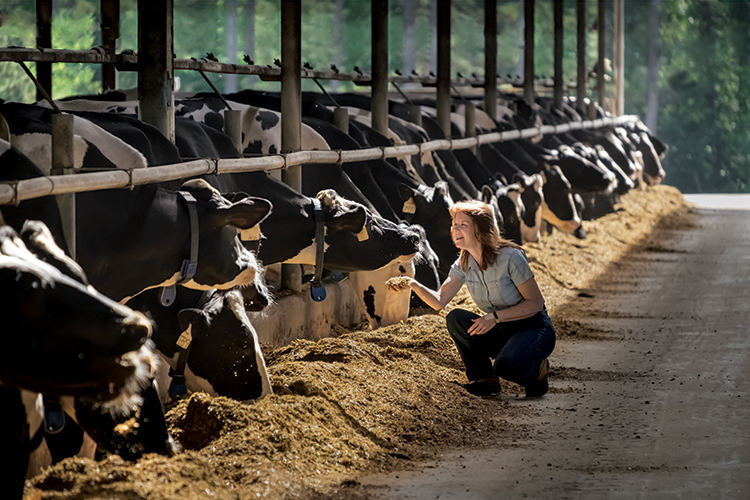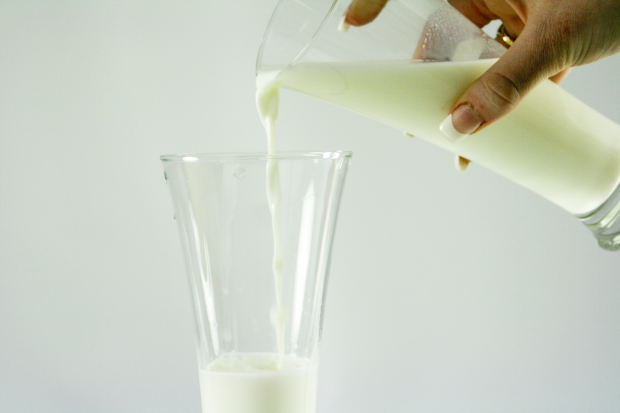Home > Georgia > Georgia Crops & Livestock > Georgia Dairy Industry is Efficient and Nutritious
Georgia Dairy Industry is Efficient and Nutritious

While consumers may reference five food groups for a balanced meal, nutritionists review more than 20 nutrients when they formulate a dairy cow’s diet.
“A cow has a better balanced diet than a majority of humans,” says Dr. Holly Ballantine, a dairy nutritionist for more than 25 years. “A balanced package is lots of different components, like proteins, carbohydrates, fats, minerals and vitamins. When nutrition and management are correct, the cow is healthy, happy and makes large volumes of milk.”
Ballantine customizes nutrition plans for dairy farms throughout Georgia and Florida as owner and operator of HTB Consulting LLC. Georgia is home to 85,000 dairy cows on 215 dairy farms, according to the latest U.S. Department of Agriculture data and Georgia Milk Producers Inc. In 2015, those farms produced nearly 1.8 billion pounds, or 209 million gallons, of milk valued at $359 million, the statistics service reports.
“I believe our Georgia dairymen are really focused on taking care of their animals from a nutritional point of view as well as cow comfort and herd health,” Ballantine says. “It is a 24/7, 365-day job.”
![Georgia dairy [INFOGRAPHIC]](https://eadn-wc01-4177395.nxedge.io/wp-content/uploads/2020/05/Screen-Shot-2016-09-27-at-3.45.58-PM.jpg) Caring for Cows
Caring for Cows
The Rodgers family pampers their 400 cows at Hillcrest Farms, a fourth-generation family farm in Dearing. Cows shade themselves from the Georgia sun in free-stall barns, in which the bovines move freely to eat, drink and rest. The cows bed on sand that the family recycles weekly and a swinging brush rubs their backs. Fans and wetting areas encourage evaporative cooling in Georgia’s subtropical climate.
All the while, the family and their crew frequent the barns and electronically record each cow’s movement, milk production and milk flow with the aid of a transponder on each animal’s neck.
“The technology gives us the ability to monitor all facets of her life and make life as comfortable as possible for that cow,” says Mark Rodgers, who farms with his brother, daughter and nephew.
The family’s elevated attention to care yields an impressive average of 105 pounds of milk per cow per day. That’s equivalent to 12.3 gallons daily per cow, a production level attained through management and nutrition. Rodgers says each of those lactating cows eats 124 pounds of feed daily, a ration that Ballantine developed specifically for their farm. She has served as the farm’s nutritionist since 1993. Rodgers keeps in contact with her several times a week about herd health and performance.
“We try to feed the cows the best, high-quality diet,” Rodgers says. “That goes a long way to improve milk production but also controls the quality components in the milk.”
 Nutrition Plan
Nutrition Plan
The combination of today’s feed prices and low milk price means that the nutrition program consumes at least 60 to 70 percent of the dairy producer’s milk check, Ballantine says.
“Because the nutrition program is a high input cost, we want everything we feed that animal to be as efficient and nutritious as possible,” she says.
The dairy diet sets its foundation on forages, commonly corn silage, sorghum silage, oats, ryegrass and haylage in Georgia. Ballantine uses university research and experience to help farmers select crop varieties with the best nutritional benefits to dairy cows.
To round out the nutrition plan that includes soybean meal and corn, Ballantine suggests byproducts, such as distillers’ grains, citrus pulp, soy hulls and whole cottonseed, all feedstuffs indigestible by non-ruminant animals.
“Cattle are using byproducts effectively as an energy and protein source,” she says. “They are taking products that cannot be used for humans or other farm animal consumption and making it into milk or meat or both. If we didn’t have a way to use it, it would go into a landfill. The cow is a very important recycler.”



